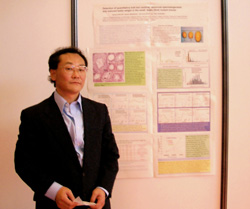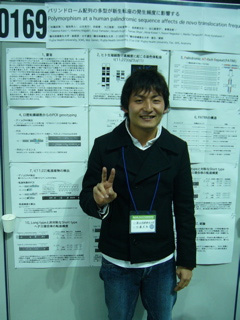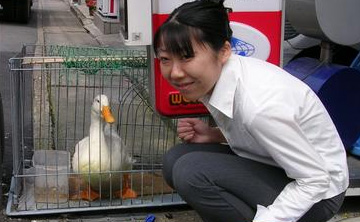 COE Research Assistants
COE Research Assistants
 Hasbaira Bolor (Chief of Research Assistants)
Hasbaira Bolor (Chief of Research Assistants)

I came from Inner-Mongolia of China and had been employed on a Technology Center of Animal Husbandry for 10-years at my hometown before I came to Japan. After learning at Japanese language school for 2-years in Okayama, I entered the Division of Applied Genetics and Physiology, Graduate School of Bioagricultural Science, Nagoya University and engaged in breeding and establishment of some strains from a sterility mouse line with small testis. I am working as a research assistant since 2006 in 21st Century COE Program of Fujita Health University, and I am very interested in meiosis and spermatogenesis.
Paper
1. Bolor H, Wakasugi N, Zhao WD, Ishikawa A.
Detection of quantitative trait loci causing abnormal spermatogenesis and reduced testis weight in the small testis (Smt) mutant mouse.
Exp Anim. 2006 Apr;55(2):97-108.
2. Bolor H, Zhao WD, Ishikawa A, Wakasugi N.
Arrest of spermatogenesis at the early meiotic stage in the small testis mutant (Smt) mice.
Exp Anim. 2005 Jul;54(4):327-37.
3. Zhao WD, Ishikawa A, Yamagata T, Bolor H, Wakasugi N.
Female mice of DDK strain are fully fertile in the intersubspecific crosses with Mus musculus molossinus and M. m. castaneus.
Mamm Genome. 2002 Jul;13(7):345-51.
 Takema Kato
Takema Kato

Takema Kato, who graduated from the Department of Bio-industry, Tokyo University of Agriculture graduate school in 2004, and has belonged to the Moleculer Genetics, ICMS, Fujita Health University as a 21st century COE research assistant since 2004. While doing genomic analysis of disease-related genes at the Development Center for Targeted and Minimally Invasive Diagnosis and Treatment as the COE theme, he studies the mechanism of chromosome aberration formation under Dr. Kurahashi's guidance. He is attending Fujita Health University Graduate School of Medicine in 2006.

4th COE International workshop
Cutting Edge of Diagnosis and Treatment of Genetic and Chromosomal Diseases
4-5 Dec, 2006
Conference
Kato, T., Inagaki, H., Ohye, T., Kogo, H., Kowa, H., Taniguchi, M., Nagaoka, K., Yamada, K., Kurahashi, H. (2005). Polymorphism of the palindromic AT-rich repeat predisposing to the frequency of de novo chromosomal translocation. The 50th Annual Meeting of the Japan Society of Human Genetics. Kurashiki. Japan, September, 19-22
Kato, T., Inagaki, H., Ohye, T., Kogo, H., Kowa, H., Kurahashi, H. (2005).
Genotype of the palindromic sequence predisposing to the frequency of de novo chromosomal translocation, 37th Fujita Medical Society, Toyoake, Japan, October, 6-8
Kato, T., Inagaki, H., Yamada, K., Kogo, H., Ohye, T., Emanuel, B.S., Kurahashi, H.(2005). Polymorphism of the palindromic sequence at the 11q23 breakpoint region affects de novo t(11;22) translocation frequency. 55th Annual Meeting of American Society of Human Genetics. Salt Lake, USA, October, 25-29.
Kato, T., Inagaki, H., Yamada, K., Kogo, H., Ohye, T., Kowa, H., Nagaoka, K., Taniguchi, M., Kurahashi, H. (2005). Polymorphism of palindromic sequence affects de novo translocation frequencies in humans, Fukuoka, Japan, December, 7-10
Kato, T., Inagaki, H., Kogo, H., Ohye, T., Yamada, K., Emanuel, B.S., Kurahashi, H.(2006)
Different mechanisms dictate the rearrangement of human palindromic sequence into deletions or translocations. 20th IUBMB International Congress of Biochemistery and Molecular Biology and 11th FAOBMB Congress. Kyoto, Japan, June, 18-23
Kato, T., Inagaki, H., Yamada, K., Kogo, H., Ohye, T., Emanuel, B.S., Kurahashi, H.(2006) Genetic variation affects de novo translocation frequencies. 11th International Congress of Human Genetics. Brisbane, Australia, August, 6-10
Kato, T., Inagaki, H., Ohye, T., Kogo, H., Yamada, K., Kurahashi, H.(2006) Frequency of de novo constitutional t(11;22) in sperm as a function of donor age. 37th Fujita Medical Society, Toyoake, Japan, October, 5-7
Kato, T., Inagaki, H., Kogo, H., Ohye, T., Yamada, K., Emanuel, B.S., Kurahashi, H.(2006). DNA secondary structure induces genomic instability leading to the recurrent 11;22 chromosomal translocation. 56th Annual Meeting of American Society of Human Genetics. New Orleans, USA, October, 9-13.
Kato, T., Inagaki, H., Kogo, H., Ohye, T., Kurahashi, H.(2006). DNA secondary structure induces genomic instability leading to the recurrent chromosomal translocation. The 51th Annual Meeting of the Japan Society of Human Genetics. Yonago. Japan, October, 17-20.
Kato, T. (2006) Palindrome-mediated chromosomal translocation in humans. The Fourth International Workshop. Nagoya, Japan, December, 4-5
Paper
Kato T, Inagaki H, Yamada K, Kogo H, Ohye T, Kowa H, Nagaoka K, Taniguchi M, Emanuel BS, Kurahashi H. Genetic variation affects de novo translocation frequency. Science. 2006 Feb 17;311(5763):971.
Kato T., Kurahashi, K. Genetic variation affects de novo translocation frequency. Experimental Medicine. 2006 June.
Kurahashi H, Inagaki H, Kogo H, Ohye T, Kato T, Emanuel BS. Chromosomal translocations mediated by palindromic DNA. Cell Cycle. 2006 Jun ; 5(12) : 1297-303
Kurahashi H, Inagaki H, Kogo H, Ohye T, Kato T, Emanuel BS. Palindrome-mediated chromosomal translocations in humans. DNA Repair. 2006 Sep 8 ; 5(9-10) : 1136-45
Nishizawa H, Pryor-Koishi K, Kato T, Kowa H, Kurahashi H, Udagawa Y. Microarray analysis of differentially expressed fetal genes in placental tissue derived from early and late onset severe pre-eclampsia. Placenta, in press
Additional (Introduction Article)
Tanita Casci. Even chromosomes have their weaknesses. Nature Reviews Genetics. 7, 241-241(01 Apr 2006)
 Terumi Mori
Terumi Mori

In my school days, I studied about the protein interaction of Extra-cellular matrix binding protein and the study of microorganism that involved in synthetic polymer degradation. I hope to acquire various skills and knowledge.
Paper
1. Mori T, Kurahashi H, Shinka T, Nakahori Y, Taniguchi M, Toda T, Iwamoto T. Candidate genes for male factor infertility-validation.
Fertility and Sterility, 2006 Nov.;86(5):1553-4.
2. Yasui N, Mori T, Morito D, Matsushita O, Kourai H, Nagata K, Koide T., Dual-site recognition of different extracellular matrix components by anti-angiogenic/neurotrophic serpin, PEDF, Biochemistry. 2003 Mar 42(11):3160-7.

 Machiko Suzuki
Machiko Suzuki
 Kayuri Nagaoka
Kayuri Nagaoka

Educated at Tohoku University (Sendai, Japan), Faculty of Science. After graduation, I had been worked at Institute of Development, Aging and Cancer for 5 years.
I am a webmaster of this website (including artworks).
Paper
1. Analysis of gene expression profiles by oligonucleotide microarray in children with influenza.
Kawada J, Kimura H, Kamachi Y, Kojima S, Nishikawa K, Nagaoka K, Taniguchi M, Kurahashi H, Morishima T. J Gen Virol 87(6):1677-83, 2006.
2. A microarray-based method for detecting methylated loci.
Hatada I, Kato A, Morita S, Obata Y, Nagaoka K, Sakurada A, Sato M, Horii A, Tsujimoto A, Matsubara K. J Hum Genet.47(8):448-51, 2002.
 Alumna: Hiroe Kowa
Alumna: Hiroe Kowa







